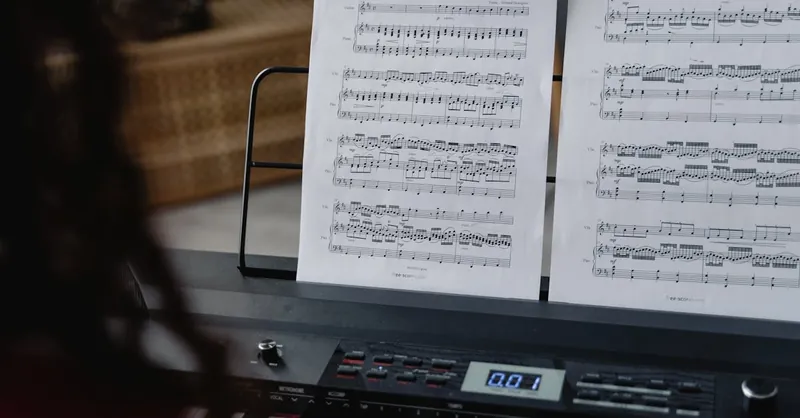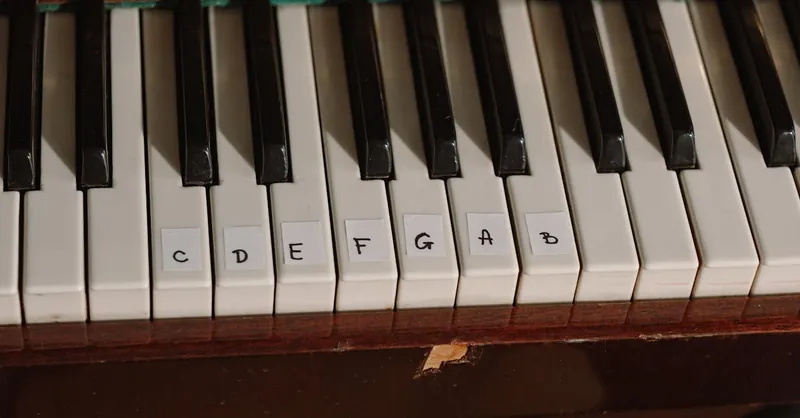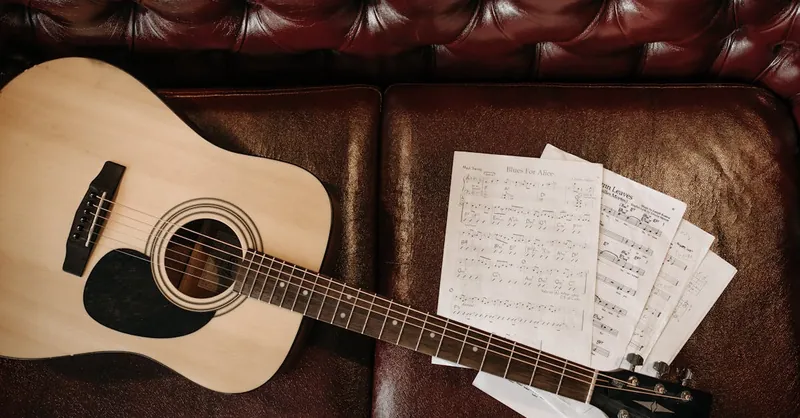Easy Songs to Learn That Teach Music Theory on Guitar & Piano
Category: Music Theory
Unlock Music Theory with Easy Songs on Guitar & Piano
Starting your music theory journey can feel overwhelming, especially when technical concepts are thrown at you without context. If you're a beginner eager to learn music theory in a fun, practical way, you’ve landed in the right place. Many beginners struggle to connect abstract theory with real musical experience — that’s where easy songs come in. This post is crafted specifically for guitar and piano beginners who want to grasp essential theory concepts while playing songs they enjoy. We’ll break down how simple, popular songs can be powerful tools for understanding chords, scales, rhythm, and harmony without drowning in jargon. Whether you’ve tried learning theory before or are just picking up your first instrument, this guide will show you how to use beginner-friendly songs to internalize music theory naturally. You’ll discover a selection of easy, well-known tracks that reinforce theory elements, complete with practical tips focused on guitar and piano. By the end, you’ll have not only learned new songs but gained insight into how music works, making your future practice more effective and enjoyable. Let’s bridge the gap between theory and play, making music learning approachable and inspiring for you.
- Unlock Music Theory with Easy Songs on Guitar & Piano
- Understanding Why Easy Songs Are Effective for Learning Music Theory
- Key Music Theory Concepts Covered by Beginner Songs
- Choosing Songs That Match Your Skill Level: Tips for Guitar and Piano Beginners
- Top 5 Easy Songs for Guitar That Teach Music Theory
- Top 5 Easy Songs for Piano That Teach Music Theory
- How to Practice These Songs to Maximize Theory Learning
- Using Chord Progressions in Easy Songs to Understand Harmony
- Integrating Scale Practice with Songs to Improve Melodic Understanding
- Rhythm and Timing Through Easy Songs: Understanding Beat, Meter, and Groove
- Tracking Your Progress and Next Steps After Learning With Songs
Understanding Why Easy Songs Are Effective for Learning Music Theory
One of the best ways to internalize music theory concepts is by applying them to songs that are simple and familiar. Easy songs serve as practical examples that bridge the gap between abstract theory and real musical experience, making complex ideas more accessible for beginners. When you learn theory through recognizable melodies and chord progressions, you engage both your analytical and creative sides, which accelerates understanding and retention.
How Simple Songs Build a Strong Foundation
- Relatable Context: Easy songs often use basic chord shapes and common scales, which help you see how theory functions in everyday music. This context makes concepts like scales, intervals, and harmonies less intimidating and easier to grasp.
- Practical Application: By playing through straightforward progressions and rhythms, you experience theory in action. This hands-on approach transforms dry textbook material into enjoyable practice that reinforces your skills.
- Motivation and Confidence: Learning songs you know and love encourages consistent practice, boosting your confidence as you notice tangible progress. Increased motivation keeps you engaged in theory study without feeling overwhelmed.
In essence, easy songs provide a natural environment for beginners to connect theory with playability. Whether on guitar or piano, these tracks highlight foundational elements such as chord construction, key signatures, and rhythmic patterns. This method not only demystifies music theory but also builds a lasting framework for advancing your musicianship.

Image courtesy of Yan Krukau
Key Music Theory Concepts Covered by Beginner Songs
Easy songs are more than just fun practice pieces—they are powerful tools for internalizing fundamental music theory concepts on both guitar and piano. Through simple melodies and chord progressions, beginners naturally encounter essential elements like chords, scales, intervals, rhythm, and harmony without the need for overwhelming technical jargon.
Chords and Chord Construction
Many beginner songs revolve around a handful of basic chords, often major and minor triads. Playing these songs helps you understand how chords are built from stacking intervals (root, third, fifth), and how to switch smoothly between chord shapes. This hands-on experience teaches you to recognize chord quality by ear and feel, which is key to mastering accompaniment on guitar and piano.
Scales and Keys
Simple songs commonly stay within one key, using notes from a specific scale like the major or natural minor scale. By learning these songs, you start internalizing scale patterns and how melodies fit within a key signature. This lays the groundwork for advanced techniques such as improvisation, soloing, and modulating between keys.
Intervals
Intervals—the distance between two notes—are integral to both melodies and harmonies. Easy songs expose you to common intervals through riffs and melodic lines, training your ear to distinguish sounds like seconds, thirds, and fifths. Developing interval recognition early strengthens your ability to read music and identify note relationships on the fretboard or keyboard.
Rhythm and Timing
Rhythmic patterns in beginner songs familiarize you with note durations (quarter notes, eighth notes) and time signatures (commonly 4/4). Practicing these songs improves your timing, counting skills, and sense of groove, which are vital for playing with others and creating dynamic performances.
Harmony and Progressions
Finally, easy songs demonstrate basic harmonic movement—how chords progress from tension to resolution within a key. Understanding popular chord progressions like I-IV-V or ii-V-I helps you anticipate musical changes and build your own arrangements or compositions confidently.
By focusing on these core concepts hidden in approachable songs, beginners develop a solid theoretical foundation while enjoying the satisfaction of playing music. This method ensures that music theory learning is immersive, meaningful, and directly connected to how guitar and piano are played in real-world settings.

Image courtesy of Tima Miroshnichenko
Choosing Songs That Match Your Skill Level: Tips for Guitar and Piano Beginners
Selecting the right songs to learn is crucial for effectively absorbing music theory while maintaining motivation and avoiding frustration. For guitar and piano beginners, choosing songs that truly fit your current skill level ensures steady progress and reinforces foundational theory concepts without overwhelming you. Here are some practical tips to help you pick songs that align perfectly with your abilities:
-
Start with Simple Chord Progressions
Look for songs that use basic chord shapes you can comfortably form and transition between. On guitar, this often means sticking to open chords like C, G, D, and Em. For piano beginners, focus on songs featuring triads in root position without complex inversions. These straightforward progressions allow you to concentrate on the theory behind chord functions and harmony rather than finger gymnastics. -
Choose Songs in Familiar Keys
Beginner-friendly songs usually stay in keys with few sharps or flats (like C major, G major, or A minor), which simplifies scale patterns and fingering on your instrument. Playing in familiar keys strengthens your understanding of key signatures and helps you internalize scale tones, building a solid theoretical foundation. -
Focus on Moderate Tempo and Rhythm
Select songs with clear, steady rhythms and moderate tempos to develop your timing and strumming or hand coordination skills without feeling rushed. Simple 4/4 time songs with predictable rhythmic patterns are excellent starting points to hone your rhythm and counting. -
Look for Repetitive Song Structures
Songs with repetitive verses and choruses provide multiple opportunities to practice and internalize chord progressions, scales, and melodic motifs. This repetition reinforces music theory concepts naturally through repetition and muscle memory. -
Use Reliable Beginner Songbooks and Online Resources
Take advantage of curated lists and tutorials tailored to beginners. These are designed to introduce theory gradually, ensuring that each song builds upon skills learned in previous ones. Websites dedicated to guitar and piano instruction often tag songs by difficulty and include sheet music or tablature optimized for beginners.
Ultimately, the key is to pick songs that feel achievable but still present subtle challenges to push your understanding of chords, scales, rhythms, and harmonic relationships forward. By matching songs to your skill level, you turn music theory from a daunting subject into an engaging, hands-on discovery. This approach not only deepens your theoretical knowledge but also keeps you eager to practice guitar or piano regularly—creating a positive feedback loop for fast improvement.

Image courtesy of Yan Krukau
Top 5 Easy Songs for Guitar That Teach Music Theory
Learning music theory through easy, popular guitar songs not only makes practice enjoyable but also provides real-world examples of core theoretical concepts. Below, we explore five beginner-friendly songs that are perfect for guitarists wanting to solidify their understanding of chords, scales, rhythm, and harmony while playing recognizable tunes.
1. “Knockin’ on Heaven’s Door” – Bob Dylan
Theory elements highlighted:
- Basic chord progressions using open chords (G, D, Am, C)
- The I–V–vi–IV progression in G major, showcasing common harmonic movement
- Chord switching and strumming patterns reinforcing rhythm and timing
This song's simple four-chord loop is an excellent introduction to key signatures and how chord functions interact to create a natural flow. Playing it helps beginners hear and feel essential chord relationships while practicing smooth transitions.
2. “Horse with No Name” – America
Theory elements highlighted:
- Use of modal harmony, primarily based on E minor and D6add9/F#
- Minimal chord changes—ideal for focusing on rhythm and groove
- Introduces learners to non-traditional chord shapes and voicings
This tune exposes players to a slightly different harmonic palette beyond major and minor triads, inviting them to explore modal sounds and how they influence mood and texture in music theory.
3. “Wonderwall” – Oasis
Theory elements highlighted:
- Incorporates slash chords and suspended chords (e.g., Em7, G6add9/F#)
- Demonstrates the concept of chord extensions and adding color tones
- Rhythmic strumming patterns develop timing and dynamic control
“Wonderwall” helps beginners understand how subtle chord alterations impact harmonic richness, expanding their chord vocabulary while reinforcing rhythm skills.
4. “Sweet Home Alabama” – Lynyrd Skynyrd
Theory elements highlighted:
- Classic I–IV–V blues-rock chord progression in the key of D major
- Explores pentatonic scales through melodic riffs and solos
- Teaches syncopated rhythms common in rock music
Playing this song strengthens a beginner’s grasp of scale-based improvisation and the importance of chord progressions in shaping song structure.
5. “Three Little Birds” – Bob Marley
Theory elements highlighted:
- Simple I–IV–V progression emphasizing major chords in A major
- Steady, upbeat rhythm typical of reggae—great for practicing groove
- Clear demonstration of diatonic harmony and song form
This track encourages learners to internalize how harmony and rhythm work together in different genres, enhancing versatility and timing precision on guitar.
By practicing these songs, guitar beginners engage actively with foundational music theory concepts like chord construction, progressions, modal interchange, scales, and rhythm. Each tune reinforces theory naturally while building essential technical skills—making your path to musical fluency both structured and enjoyable.

Image courtesy of Alexander Hamilton
Top 5 Easy Songs for Piano That Teach Music Theory
Just like with guitar, learning music theory through beginner-friendly piano songs offers a hands-on, engaging way to internalize foundational concepts. Piano’s visual layout makes it especially suited for exploring scales, chords, intervals, and harmonic patterns—all wrapped up in memorable melodies and progressions. Below are five easy piano pieces that help beginners grasp essential theory elements while developing practical playing skills.
1. “Let It Be” – The Beatles
Theory concepts covered:
- Clear demonstration of I–V–vi–IV chord progression in C major, highlighting diatonic harmony
- Uses simple triads and inversions, ideal for learning chord construction and voice leading
- Steady rhythm and phrasing to develop timing and expressiveness
Playing “Let It Be” helps beginners understand how common progressions form the backbone of countless songs, reinforcing key signatures and smooth chord transitions on the piano.
2. “Clocks” – Coldplay
Theory concepts covered:
- Repetitive arpeggiated chords emphasize broken chord patterns and rhythmic subdivision
- Primarily in the key of E♭ major, facilitating practice with flats and key signature awareness
- Introduces use of syncopation and simple melodic motifs aligned with harmony
This piece teaches coordination between hands and rhythm control, while showcasing how arpeggios can add texture to chord progressions—a vital skill for piano players.
3. “Someone Like You” – Adele
Theory concepts covered:
- Explores minor key harmony (A minor) through basic seventh chords, deepening understanding of chord extensions
- Incorporates stepwise melodic motion highlighting intervals within the scale
- Slow tempo encourages focus on dynamics and expressive timing
Beginning pianists can learn how emotional depth in music arises from harmonic choices and melody interplay, making theory feel alive and meaningful.
4. “Heart and Soul” – Hoagy Carmichael
Theory concepts covered:
- Classic 8-bar pattern using I–vi–IV–V chords, perfect for mastering basic chord progressions in C major
- Simple bass line combined with melody illustrates counterpoint and hand independence
- Repetition develops muscle memory and familiarity with common harmonic cycles
A timeless teaching piece, “Heart and Soul” cements how chord relationships create song structure and harmonic flow on piano.
5. “Fur Elise” (Opening) – Ludwig van Beethoven
Theory concepts covered:
- Introduces classical melodic phrasing and scale patterns in A minor
- Develops recognition of intervals and arpeggios within a memorable motif
- Enhances finger dexterity connected to theoretical understanding of note relationships
Though a classical piece, the recognizable opening is approachable for beginners and connects theory with stylistic articulation and phrasing.
By working through these accessible piano pieces, beginners build practical knowledge of chords, scales, intervals, and rhythm within familiar musical contexts. Each song reinforces core music theory concepts essential for progressing confidently from simple melodies to more complex compositions, providing a well-rounded foundation for piano learning and musicianship.

Image courtesy of cottonbro studio
How to Practice These Songs to Maximize Theory Learning
To fully unlock the music theory embedded in easy songs on guitar and piano, deliberate and mindful practice is essential. Rather than rushing through pieces, adopting focused techniques accelerates your understanding and helps internalize theoretical concepts seamlessly alongside technical skills.
1. Practice Slowly and Attentively
Start by playing songs at a reduced tempo, focusing on accuracy of notes, chords, and rhythms. Slow practice gives your brain and fingers time to connect theory concepts with physical movements, such as how chord shapes relate to intervals or how scale tones form melodies. Use a metronome to keep steady timing, gradually increasing speed only after mastering each section. This deliberate slow play deepens your internalization of key signatures, rhythmic patterns, and harmonic functions.
2. Break Songs Into Theory-Focused Sections
Analyze each part of the song separately—intro, verse, chorus—and identify key theoretical elements like chord progressions, scale usage, or interval leaps. Practice these fragments repeatedly with the theory in mind. For instance, when playing a chord progression, consciously note how it fits within the song’s key and how tensions resolve. On piano, experiment with voicing variations to understand chord construction; on guitar, try identifying chord tone roots and extensions by ear and visually on the fretboard.
3. Use Focused Listening to Reinforce Theory
Listening actively to the songs you’re learning reveals practical applications of theory concepts. Pay attention to how melodies relate to underlying chords, how rhythm sections maintain groove, and how dynamics affect harmonic movement. Listening critically while following along with your instrument strengthens your aural skills, helping you recognize intervals, identify scale patterns, and discern harmonic progressions in real music.
4. Integrate Theory Exercises With Song Practice
Complement playing songs with targeted exercises based on the theory they contain. For example, if a song uses the I–IV–V progression, practice those chords independently in various positions and keys. When a melody highlights certain intervals, work on ear training drills to identify them. This integrated approach solidifies the connection between abstract concepts and their tangible expressions on guitar or piano.
By combining slow, deliberate playing with theory-focused analysis and attentive listening, you transform simple songs into rich learning experiences. This method not only enhances technical ability but also builds a deep, intuitive grasp of music theory—ensuring that your practice sessions are both productive and inspiring as you progress on your guitar or piano journey.

Image courtesy of Photo By: Kaboompics.com
Using Chord Progressions in Easy Songs to Understand Harmony
A fundamental way to grasp harmony is by exploring common chord progressions found in easy songs, especially on guitar and piano. These progressions are the building blocks of countless popular tunes and serve as practical examples of how chords work together to create musical movement and emotional impact. For beginners, learning to recognize and play these sequences not only demystifies harmonic function but also lays a strong foundation for applying music theory creatively.
Common Beginner-Friendly Chord Progressions and Their Theory Importance
Many simple songs revolve around a handful of widely used chord progressions that illustrate the relationships between tonic, subdominant, and dominant chords. Here are some of the most important ones for beginners:
- I–IV–V Progression
- Found in genres from rock to blues and pop
- Demonstrates movement between tonic (I), subdominant (IV), and dominant (V) chords
-
Reinforces the concept of functional harmony and tension-resolution in music
-
I–V–vi–IV Progression
- One of the most ubiquitous progressions in modern music
- Combines major and minor chords to create emotional variety
-
Offers insight into how diatonic chords relate within a key
-
ii–V–I Progression
- Standard in jazz and many ballads
- Introduces chord substitutions and smoother voice leading
- Helps expand your understanding of chord extensions and transitions
By practicing songs that utilize these progressions, such as “Let It Be” on piano or “Knockin’ on Heaven’s Door” on guitar, beginners hear firsthand how harmony creates flow and shapes a song’s character. This experience solidifies your grasp of how chords function not just as isolated shapes but as part of a connected system.
How Working with Chord Progressions Builds Your Theory Foundation
- Ear Training: Repeatedly playing and listening to chord progressions trains your ear to anticipate harmonic changes and recognize chord qualities (major, minor, dominant).
- Visual and Tactile Familiarity: On guitar, shifting between common chord shapes ingrains muscle memory linked to theory concepts. On piano, seeing chord tones laid out visually strengthens note recognition within harmonies.
- Improvisation and Composition: Understanding these progressions empowers you to create your own music or improvise solos that fit the harmonic context, bridging theory with creativity.
- Transposition Skills: Knowing chord progressions by function (I, IV, V) rather than fixed chords allows beginners to transpose songs easily to different keys, enhancing versatility.
Ultimately, using easy songs with familiar chord progressions makes learning harmony approachable and practical. This focused exposure equips you with essential tools to analyze, play, and compose music confidently on both guitar and piano—turning theoretical knowledge into your musical intuition.

Image courtesy of Pavel Danilyuk
Integrating Scale Practice with Songs to Improve Melodic Understanding
One of the most effective ways to deepen your melodic understanding and intuition is by directly linking scale practice to the songs you’re learning on guitar and piano. Instead of treating scales as isolated exercises, integrating them into real musical contexts—such as melodies and solos within easy songs—helps you internalize the sound and function of scales effortlessly. This practical approach enhances both your technical skills and your aural recognition, making theoretical knowledge more memorable and useful.
How to Tie Simple Scales to Your Songs for Better Music Theory Intuition
-
Identify the Song’s Key and Scale
Start by determining the key of the song you’re practicing, which reveals the relevant scale—often a major, natural minor, or pentatonic scale. Playing the scale alongside the song, either as a warm-up or integrated into solos and fills, connects the abstract scale pattern with the song’s melodic language. -
Play Scale Tones Within Melodies
Notice how the song’s melody uses specific scale degrees. Practice playing these note patterns on your instrument to internalize intervals and tonal relationships. This exercise reinforces your understanding of how scales form the foundation of melodies, improving your ear for pitch and phrasing. -
Improvise Using Scales Over Chord Progressions
Use the identified scale to experiment with simple melodic improvisations over the song’s chords. On guitar, practice scale runs that fit the chord shapes you’re using; on piano, try creating melodic phrases within the scale that complement the harmony. This bridges theory with creativity and promotes fluid movement between chords and melodies. -
Connect Scale Practice to Common Licks or Riffs
Many beginner songs contain riffs or licks rooted in scale patterns—especially pentatonic or major/minor scales. Isolating these sections and practicing their underlying scales helps you understand how scale notes translate into memorable musical phrases.
Benefits of Integrating Scales with Song Learning
- Improves Your Ear for Melody and Harmony: By hearing and playing scales in the context of songs, you develop a sharper ear to distinguish scale tones and their emotional qualities.
- Enhances Fingerboard and Keyboard Fluency: Practicing scales alongside chord shapes and song riffs builds muscle memory that makes navigating your instrument more intuitive.
- Builds a Strong Foundation for Improvisation: As you recognize how scales fit within songs, you gain confidence to craft your own melodies, solos, and variations rooted in solid theory.
- Reinforces Theoretical Concepts in a Practical Way: Learning scales directly from songs transforms abstract theory into tangible musical experiences that stick with you longer.
By weaving scale practice seamlessly into your song learning routine, you turn passive theory memorization into an active, enjoyable process. This method cultivates a natural sense of melody, equipping guitar and piano beginners with the vital skills needed to progress musically while keeping theory intimately connected to what you love playing.

Image courtesy of Tima Miroshnichenko
Rhythm and Timing Through Easy Songs: Understanding Beat, Meter, and Groove
Mastering rhythm and timing is essential for any musician, and easy songs offer a practical, enjoyable way to develop these critical skills on guitar and piano. By engaging with approachable songs featuring clear beats and straightforward meters, beginners can internalize foundational rhythmic concepts like pulse, time signatures, and groove, which are vital for playing in time and with expressive feel.
Key Rhythmic Concepts Learned Through Beginner Songs
-
Beat and Pulse: Most beginner songs emphasize the steady pulse—the regular “heartbeat” of the music—which helps you develop consistent timing. Practicing with a metronome or tapping along enhances your ability to feel and keep the beat naturally.
-
Simple Time Signatures: Many easy songs use common time signatures like 4/4 or 3/4, offering the perfect environment to understand how beats are grouped into measures. This familiarity allows you to count confidently, anticipate downbeats and upbeats, and better follow sheet music or tabs.
-
Note Values and Subdivisions: Songs with straightforward rhythms introduce basic note durations such as quarter notes, eighth notes, and rests. Learning these shapes on your instrument teaches the relationship between rhythmical patterns and their timing, which is crucial for syncing with other musicians.
-
Groove and Feel: Rhythm isn’t just about playing notes on time—it also involves dynamics, accent placement, and flow that create a song’s unique groove. Beginner-friendly tunes encourage you to experiment with strumming patterns on guitar or hand rhythms on piano that capture the song’s vibe, cultivating your rhythmic expression.
Practical Benefits of Rhythm-Focused Song Learning
-
Improves Internal Clock: Regular practice of songs with steady rhythms trains your internal timing, making it easier to stay in sync with backing tracks, bands, or accompaniments.
-
Strengthens Coordinated Movement: For guitarists, strumming and chord changes demand rhythmic precision, while pianists develop hand independence and timing between bass and melody lines through rhythmically engaging pieces.
-
Builds Confidence in Ensemble Playing: Understanding common rhythmic patterns from familiar tunes prepares you for jamming or group rehearsals, where keeping time is paramount.
-
Facilitates Advanced Rhythmic Skills: Once basics are mastered through easy songs, you can gradually explore syncopation, polyrhythms, and varied meters with confidence.
By choosing beginner songs with clear and manageable rhythmic structures, guitar and piano players gain a solid rhythmic foundation that naturally supports all other areas of music theory. This approach transforms abstract timing concepts into tangible skills, ensuring your rhythm and groove become as strong as your melodic and harmonic knowledge.

Image courtesy of Stephen Niemeier
Tracking Your Progress and Next Steps After Learning With Songs
As you continue learning music theory through easy songs on guitar and piano, it’s important to track your progress and plan your transition towards more complex pieces and advanced theory topics. Recognizing your achievements not only fuels motivation but also clarifies which skills need further development before tackling new challenges. Here are some encouraging tips and practical steps to guide you beyond beginner-level songs while deepening your music theory knowledge.
How to Monitor Your Growth Effectively
-
Set Clear, Measurable Goals
Define specific objectives related to both playing and theory, such as mastering smooth chord changes in 4/4 time, identifying intervals by ear, or confidently improvising within a scale. Tracking these milestones helps you see tangible improvements and maintain focus. -
Maintain a Practice Journal
Document the songs you learn, theory concepts encountered, difficulties faced, and breakthroughs achieved. This reflection reinforces learning and highlights patterns in your progress, guiding your future practice priorities. -
Record Yourself Playing
Listening back enables objective assessment of timing, accuracy, and expression. It also helps you identify areas where theoretical understanding (like chord voicing or rhythmic consistency) can improve through targeted practice.
Transitioning to More Complex Pieces and Advanced Theory
Once you feel comfortable with easy songs and fundamental theory elements, gradually challenge yourself with songs featuring:
- More intricate chord voicings and extended harmonies, such as seventh, ninth, or suspended chords, to expand your harmonic vocabulary.
- Varied key signatures and modes, pushing your comprehension of tonal centers beyond familiar major and minor scales.
- Complex rhythms and time signatures, including syncopation, triplets, or odd meters, which enhance your rhythmic versatility.
- Melodic embellishments and improvisation, encouraging creative application of scale knowledge and interval recognition.
Strategies for Deepening Music Theory Understanding
- Enroll in focused theory courses or use theory apps that build systematically on your existing knowledge, blending theoretical exercises with your instrument practice.
- Explore ear training regularly to internalize intervals, chord qualities, and rhythmic patterns, improving your musical intuition.
- Analyze sheet music or tablature of intermediate songs to identify and understand new theory concepts within authentic musical contexts.
- Begin composing or arranging simple pieces that incorporate learned theory, fostering practical creativity and reinforcing theory from a new perspective.
By tracking your progress meticulously and easing into advanced songs and theory topics with confidence, you transform music learning into a continuous, rewarding journey. This deliberate approach ensures that your guitar and piano skills grow hand-in-hand with a solid, deepening understanding of music theory—turning beginner knowledge into lasting musicianship.

Image courtesy of Photo By: Kaboompics.com
